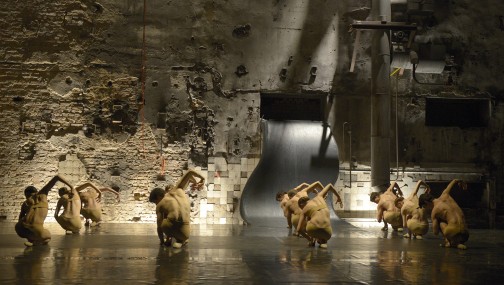Ahead of me, muscular bodies throw wild shapes, glistening with sweat, while earth-shaking sub bass and pounding beats fill every corner of the room, the sound pristine and distortion-free. Lights flash dangerously off derelict brick walls, cables dangling carelessly amongst the heavy pipes and concrete pillars that line the room like random pinstripes in the building’s fabric. I, meanwhile, sit quietly: inert, observing, fascinated. It’s just another night at Berlin’s Berghain. Or is it?
Well, no. Far from it, in fact, and not just because tonight finds us in the Halle At Berghain as opposed to the upstairs space more familiar to those who make it past Berghain’s legendary weekend doorman. It’s also not because there’s a bus buried up to its back axle in the floor at one end of the room. No: this is a remarkable, exceptional occasion. This is Masse, a collaboration between musicians Henrik Schwarz, Marcel Dettmann and Frank Wiedemann (of Âme), DIN (Efdemin and Marcel Fengler) and the renowned Staatsballett Berlin. And yes: you read that right. This is a night of ballet.
If it’s true that tonight – and indeed during the other ten evenings at which Masse is being performed, for which tickets are like gold dust – many of the people filling the hall have never, or at least only rarely, seen a ballet performance before, it’s equally likely that there are others present for whom the idea of visiting Berghain must have seemed unthinkable before this ambitious project was announced. But Masse has created a significant buzz in the city, even though this isn’t the first time the disciplines have collided. The reason for this is entirely straightforward: Masse is, if you’ll forgive the inevitable West End theatre critic’s standby, a must see.
Even to the uninitiated, it’s clear that the dancers are extraordinary. While ballet in the 21st Century has become largely the preserve of the older generation’s elite – though recent phenomena like Black Swan have done it no harm in terms of broadening its appeal – the sheer physicality of much of the performance is impossible to ignore. Whether moving in slow motion beneath a squall of white lights, sliding and gliding gracefully across the floor, or rushing from one side of the stage to the other, sometimes balancing other bodies, the movement of these dancers has an energy and sinewy vitality that is quite simply thrilling.
Divorced from the formality of classical accompaniment, or the inaccessibility of modern avant-garde scores, their choreography is re-contextualised amid far more familiar scenery: almost exclusively electronic soundtracks, a fair part of which could easily be heard on the other side of the building in either Berghain’s main hall or its sister room, Panoramabar. Though divided into separate performances, all three are united by a common theme: the physical and social phenomenon of mass. To the novice, it’s hard to grasp fully the connection between theme and choreography, but those drawn to the event by the men behind the music will fully appreciate the unusual union of dance and techno, house and ambient electronica that Masse represents.
Henrik Schwarz’s score for the third section is perhaps the most conventional – in fact, parts of it sound like they might have been recorded by Joy Division had they formed this decade – and is perhaps spoiled by the first appearance of vocals during the night, an aggressive declaration that "You don’t know jack" rather breaking the spell cast by masked dancers. Its more acoustic textures, however, provide contrast with what precedes: Dettman and Wiedemann provide glistening minimalism and Reichian ambience, while DIN opens proceedings with slowly swelling techno whose richness is perfectly served by Berghain’s sound system. Each, however, inspires movement and passion that perfectly complements it.
There are, of course, one or two awkward moments: a dancer peering into his trousers, or the sense that the second section’s costumes might have worked better on Battlestar Galactica (though there they might be considered a little racy). But there are, throughout Masse, long periods of breathtaking beauty and startling moments of spectacle, not least the unexpected depiction of the ascent of man itself. Perhaps a small degree of novelty creeps into the experience – whether a regular series featuring techno and ballet could stand up to scrutiny and pull in punters in such numbers is hard to say – but the conviction with which everyone involved has immersed themselves in the possibilities of this project is evident. Cultural tourism it may be, therefore, but it’s also deeply, wildly engaging.


